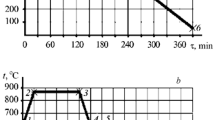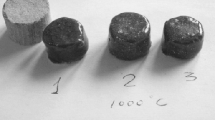The physical-chemical processes involved in the formation of the cellular structure of heat-insulation building glass materials as a result of thermoplastic sintering of batch at temperatures 600 – 870°C are examined. Such a cellular glass formation process occurs because the significant gas-phase volume formed at low viscosity diffuses in the thermoplastic ceramic mass and in so doing creates the pore structure of the cellular heat-insulation glass.



Similar content being viewed by others
Notes
Here and below, weight content, %.
References
S. A. Gerk and V. A. Smolii, “Investigation of the composition and structure of wastes from the fuel-energy complex using electron-microscopic and elemental analysis,” Izv. Vysh. Uchebn. Zaved., Severo-Kavkazskii Region, Ser. Tekh. Nauki, No. 4(173), 76 – 79 (2013).
E. A. Yatsenko, N. N. Efimov N. N. Kosarev, and V. A. Rytchenkova, “Problems of comprehensive processing of ash-slag wastes and synthesis based on them of silicate materials for construction,” Tekh. Tekhnol. Silikatov, No. 2, 17 (2010).
E. A. Yatsenko, V. A. Smolii, B. M. Gol’tsman, and A. S. Kosarev, “Development of compositions and investigation of the properties of block and granular foam glass fabricated using slag wastes from thermal power plants,” Izv. Vysh. Uchebn. Zaved., Severo-Kavkazskii Region, Ser. Tekh. Nauki, No. 5, 115 – 119 (2012).
E. A. Yatsenko, A. P. Zubekhin, V. M. Gol’tsman, et al., “Investigation of the factors influencing the properties and structure of fold slag glass,” Steklo Keram., No. 4, 3 – 6 (2014); E. A. Yatsenko, A. P. Zubekhin, V. M. Gol’tsman, et al., “Investigation of the factors influencing the properties and structure of foamed slag glass,” Glass Ceram., 71(3 – 4), 111 – 114 (2014).
E. A. Yatsenko, A. P. Zubekhin, V. A. Smolii, et al., “Conserving technology of heat-insulation-decorative glass-composite material based on ash-slag wastes,” Steklo Keram., No. 6, 34 – 38 (2015); E. A. Yatsenko, A. P. Zubekhin, V. A. Smolii, et al., “Conserving technology of heat-insulation-decorative glass-composite material based on ash-slag wastes,” Glass Ceram., 72(5 – 6), 216 – 219 (2015).
E. A. Yatsenko, V. A. Smolii, A. S. Kosarev, et al., “Synthesis of foam glass based on combined wastes from industry,” Nauch. Obozr., No. 8, 70 – 75 (2013).
V. A. Smolii, A. S. Kosarev, E. A. Yatsenko, and B. M. Gol’tsman, “Development of a technology for the production of efficient energy-conserving cellular heat-insulating building glass material,” Izv. Vysh. Uchebn. Zaved., Severo-Kavkazskii Region, Ser. Tekh. Nauki, No. 4(185), 128 – 132 (2015).
A. S. Kosarev, V. A. Smolii, E. A. Yatsenko, and B. M. Gol’tsman, “Technological particular’s of obtaining cellular glass used as heat-insulating layer in silicate multiple-layer composite heat-insulating-decorative material,” Tekh. Tekhnol. Silikatov, No. 4 (2016).
V. A. Smolii, A. S. Kosarev, and E. A. Yatsenko, “Dependence of the reactivity and forming activity of compositions of organic and inorganic poor-generators of cellular heat-insulating building glass material on their ratios and properties,” Tekh. Tekhnol. Silikatov, 22(4), 7 – 12 (2015).
V. A. Smolii, E. A. Yatsenko, A. S. Kosarev, and V. M. Gol’tsman, “Development of compositions and technological parameters for the synthesis of cellular class heat-insulation construction materials with prescribed density,” Steklo Keram., No. 6, 22 – 25 (2016); V. A. Smolii, E. A. Yatsenko, A. S. Kosarev, and V. M. Gol’tsman, “Development of compositions and technological parameters for the synthesis of cellular class heat-insulation construction materials with prescribed density,” Glass Ceram., 73(5 – 6), 219 – 221 (2016).
This scientific research was performed at YuRGPU (NPI) was supported by a stipend awarded by the President of the Russian Federation to young scientists and graduate students performing promising scientific research and development work in high-priority directions of modernization of the Russian economy in the period 2015 – 2017 (No. SP-1219.2015.1 (V. A. Smolii)) on the ‘Development of a Technology for the Production of Efficient Energy-Conserving Cellular Heat-Insulating Building Glass Material.’
Author information
Authors and Affiliations
Corresponding author
Additional information
Translated from Steklo i Keramika, No. 2, pp. 20 – 22, February, 2017.
Rights and permissions
About this article
Cite this article
Smolii, V.A., Kosarev, A.S. & Yatsenko, E.A. Cellular Heat Insulation Building Glass Materials Based on Wastes from Thermal Power Plants and Ferrous Metallurgy. Glass Ceram 74, 52–54 (2017). https://doi.org/10.1007/s10717-017-9927-y
Published:
Issue Date:
DOI: https://doi.org/10.1007/s10717-017-9927-y




